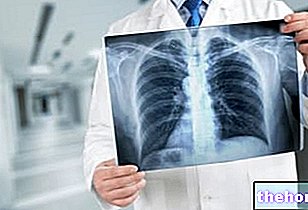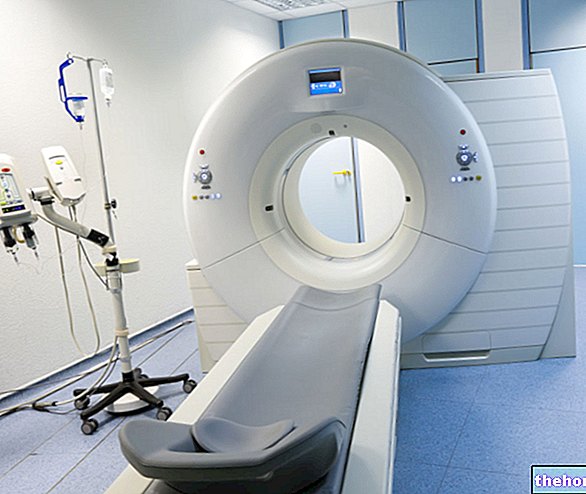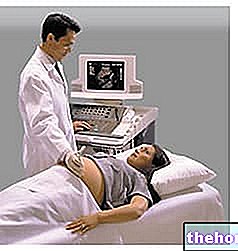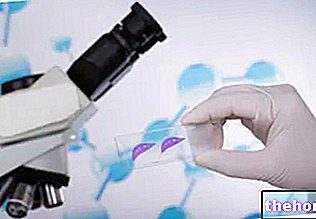Generality
The myocardial scintigraphy is a diagnostic test of nuclear medicine, which allows to know the state of health of the coronary arteries and the blood supply of the myocardium.

SPECT of myocardial perfusion; arrows indicate ischemic areas
Being a nuclear medicine technique, it requires the injection of radiopharmaceuticals, that is substances containing radioactive isotopes. Once in the organism, these radiopharmaceuticals are traced by means of a special detection tool, which provides very clear and significant images.
Myocardial scintigraphy involves two moments: in a first phase, the heart is analyzed while it is undergoing an effort and, in a second phase, the heart is observed while it is left at rest.
In view of the examination, it is necessary to follow some important indications, which will be presented by the doctor during a previous visit.
During or following a myocardial scintigraphy it is possible that some complications arise, however these are quite rare events.
Brief reminder of the anatomy of the heart
The heart is a hollow organ, composed of four contractile cavities: two are located on the right and are called the right atrium and the right ventricle; the other two are on the left and are called the left atrium and left ventricle.
The oxygen-poor blood flows through the atrium and the right ventricle, which must be directed to the lungs for oxygenation; the oxygen-rich blood from the lungs passes through the atrium and the left ventricle. , to be pumped to the various organs and tissues of the body.
The pumping of blood to the lungs and the rest of the body is guaranteed by the muscular structure that constitutes the atria and the ventricles and which as a whole is called the myocardium.

Figure: anatomy and blood circulation inside the heart. The right cavities of the heart (including the vessels that reach and depart there) are indicated with blue arrows, while the left cavities (also in this case, including vessels) are highlighted with the red arrows As you can see, the blood reaches the right atrium and then to the right ventricle, through the hollow veins. From the right ventricle, it goes towards the lungs, to oxygenate; once "loaded" with the necessary oxygen, it returns to the heart but from the left atrium side, through the pulmonary veins. Passed to the left ventricle, it is pumped into the circulation.
The myocardium receives nutrition and oxygen from the coronary arteries.
Inside the heart, the regulation of blood flow between the various compartments and to the outgoing blood vessels is done by four valves, also known as heart valves.
What is myocardial scintigraphy?
Myocardial scintigraphy is a diagnostic procedure of nuclear medicine, which allows to analyze the blood flow inside the coronary arteries, the perfusion of the myocardium and the functionality of the heart.

In this way, it is possible to compare the blood supply of the myocardium during a stressful condition of the heart and during a moment of rest.
WHAT IS NUCLEAR MEDICINE?
Nuclear medicine is that branch of medicine that is based on the use of radioactive substances (the so-called radiopharmaceuticals) for diagnostic and therapeutic purposes.
A radiopharmaceutical is an injectable medicine that contains radionuclides, which are radioactive isotopes.
Once injected, radiopharmaceuticals can interact specifically with a specific biological tissue (like a normal drug) and, by virtue of their radioactive properties, can be monitored in their spread by means of a "special radioactivity detection instrument (gamma-camera). In this way, this complex instrumentation provides very clear images of how, over time, the radiopharmaceutical is distributed within the organism.
Scintigraphy is a diagnostic test of nuclear medicine, based on the detection of the radiations emitted by an organism after the administration, in the latter, of radiopharmaceuticals. These radiations, suitably processed by an instrument ad hoc, allow you to investigate the location, shape, size and function of various organs, including the heart, thyroid, bones, brain, liver, kidneys and lungs.
In the light of what has just been stated, it is possible to understand why radionuclides are also identified with the word "tracers".
Please note. The distribution in a certain tissue or the interaction with a given organ by radioactive isotopes depends exclusively on the drug to which they are bound. Therefore, the choice of the pharmacological preparation is of fundamental importance for the correct execution of the examination. For example, for a thyroid analysis it is necessary to resort to the use of a drug that specifically diffuses in this organ of the body; the same goes for the heart.
MYOCARDIAL SCINTIGRAPHY WITH PHARMACOLOGICAL STRESS
Stress testing is not the only way to study myocardial blood supply in a stressful condition for the heart.
In fact, there is the possibility of mimicking a cardiac effort, following a "physical activity of a certain entity, with the administration of particular drugs."
These pharmacological preparations induce the dilation of the coronary arteries (so there is an increase in blood flow), just like during physical exercise.
Cardiologists use so-called drug stress myocardial scintigraphy instead of an exercise test (also called stress myocardial scan) when the patient is unable to perform the intended physical activity. For example, such an occurrence it can occur in those cases where the patient is very old and has difficulty moving.
INVASIVE OR NON-INVASIVE?
Myocardial scintigraphy is an invasive procedure, as it involves the venous injection of radioactive isotopes.
However, it is considered less invasive than cardiac catheterization techniques, during which the cardiologist inserts a catheter into an "artery of the body and then leads it to the heart for subsequent operations.
When you do
Usually, cardiologists use a myocardial scan when they suspect the presence of coronary artery disease.
In medical language, coronary artery disease means any disease affecting the coronary arteries, characterized by a narrowing of these arterial vessels supplying the myocardium.
The coronary arteries can be narrowed by blood clots or the so-called atheromatous plaques, i.e. deposits essentially consisting of lipids, platelets, white blood cells and smooth muscle cells.
If the narrowing of the coronary arteries is greater than 70%, the blood supply to the myocardium is insufficient to support cardiac activity; in these situations we speak of myocardial ischemia or ischemic heart disease.
Especially if left untreated, myocardial ischemia could represent the prelude to myocardial necrosis or, better, to areas of myocardium not adequately reached by the blood; this condition is known as myocardial infarction or heart attack.
The main symptoms of coronary artery disease
The symptoms of coronary artery disease resemble those of many other heart problems, not specifically due to a coronary artery disease.
However, it is worth remembering them, because the sooner they recognize themselves and expose themselves to their doctor, the greater the chances of a cure.
Typical manifestations of coronary artery disease are: chest pain, dyspnoea (both from exertion and at rest), a sense of asthenia, heartbeat, excessive sweating and distension of the neck veins.
OTHER CONDITIONS THAT REQUIRE MYOCARDIAL SCINTIGRAPHY
In addition to analyzing the characteristics of a coronary artery disease in progress, myocardial scintigraphy is also performed after:
- A heart attack. It serves to identify the precise area of myocardium affected by the necrosis process.
- A therapeutic treatment for the restoration of coronary flow. For example, it can be performed after coronary artery bypass surgery, which is a procedure to bypass the occluded coronary artery (s) by inserting a "new" blood vessel; or after a "coronary angioplasty with stenting, which is a method for reopening the occluded coronary or coronary arteries using an inflatable balloon and a small metal cylinder (stent).
Preparation
Before myocardial scintigraphy, the patient must be made aware of all the pre-operative indications necessary for the correct and safe implementation of the diagnostic procedure.
To take care of this aspect is the cardiologist who will carry out the examination or a qualified member of his staff.
The most important pre-operative indications to be followed can be summarized in the following points:
- Notify the cardiologist (or whoever takes his place on the occasion) of any possible allergy to drugs, local anesthetics and various materials used during the scintigraphy.
- Complete fast for at least 12 hours. By complete fasting s "means the abstention from food and liquids. Only water is an exception and can only be taken up to a few hours before the procedure.
- Avoid any medicines or substances containing theophylline or caffeine. To be precise, the intake of preparations containing theophylline should be interrupted 2-3 days before the examination; while the caffeine intake should be stopped at least 12-24 hours before.
Individuals suffering from bronchial asthma are reminded that some medications for this disorder are based on theophylline. - Notify your cardiologist if you are (or suspect you are) pregnant.
- Notify the cardiologist of all medications you are currently taking. In this regard it should be remembered that medicines for the heart must be suspended at least 24 hours before the examination.
- Notify your cardiologist if you have a pacemaker, which is an electronic device for correcting a "cardiac arrhythmia."
- If you are going to undergo an exercise myocardial scan, remember to bring comfortable clothing for the exercise test (including shoes) with you on the day of the procedure.
It is during the preliminary meeting, in which all the aforementioned indications are presented, that the patient can question the doctor about the details or doubts regarding the procedure.
Procedure
Myocardial scintigraphy is an outpatient procedure that takes place in three stages:
- an initial phase, which is the same for the exercise version and for the pharmacological stress version;
- an intermediate stage, which is specific to each version;
- a final phase, common to both procedural versions.
INITIAL PHASE
The initial phase typically involves the following steps:
- Removal of any jewelry, earring and other objects, which could in any way interfere with the implementation of the procedure.
- Dressing of the patient with clothes suitable for the following stages.
- By the hand of a nurse, insertion of a needle-cannula into a vein in the arm or hand. The needle-cannula is used for the venous administration of the radioactive substance and, in the case of myocardial scintigraphy with pharmacological stress, also for the injection of the drug for the dilation of the coronary arteries.
- Also by a qualified member of the medical staff, connection of the patient to an electrocardiogram (ECG) machine and an instrument for measuring blood pressure. Heart rate (via ECG) and blood pressure are two parameters that must be monitored from the beginning to the end of the procedure.
MYOCARDIAL STRESS SCINTIGRAPHY: INTERMEDIATE PHASE
At the end of the first part of the procedure, the patient is invited to use the machine for the stress test; machinery that can be a treadmill (or treadmill) or an exercise bike.
The level of activity he is subjected to is at the discretion of the cardiologist and depends on several factors, including age, heart function and the general health of the patient.
The injection of the radiopharmaceutical takes place only after the heartbeat - which is constantly monitored by ECG - has reached the most suitable exercise rate for the characteristics of the individual under examination.
Once the radiopharmaceutical has been injected, the patient must continue exercising for a few more minutes, waiting for the radionuclides to diffuse into the stressed heart.

MYOCARDIAL SCINTIGRAPHY WITH PHARMACOLOGICAL STRESS: INTERMEDIATE PHASE
During the intermediate phase of myocardial scintigraphy with drug stress, the patient is placed on a hospital bed and given the drug that mimics physical exertion.
As with exercise myocardial scintigraphy, your heart rate and blood pressure are monitored step by step.
The injection of the radiopharmaceutical occurs when the imitation of stress from exertion has reached the desired connotations.
FINAL PHASE
After the injection of the radiopharmaceutical, it is usually necessary to wait 40-60 minutes for the acquisition of images of the heart by gamma-camera. This expectation is due to the fact that, in the first few minutes, the radiopharmaceutical also temporarily spreads to the abdominal splanchnic organs and lungs, and this could compromise the quality of the images.
Acquisition by gamma camera takes place with the patient lying on a bed connected to the equipment.
It is essential that, at this point in the procedure, the individual under examination remains completely immobile.
After the image collection, it is necessary to wait 3 to 6 hours before myocardial evaluation at rest. During this time, unless otherwise indicated by the doctor, it is allowed to drink (water) but not eat.
The examination at rest is very simple: the patient is made to sit on a hospital bed and the cardiologist (or his assistant) injects the radiopharmaceutical through the needle cannula.
Even at this juncture, image acquisition does not occur before 40-60 minutes have elapsed.
HOW LONG DOES A MYOCARDIAL SCINTIGRAPH EXACTLY LAST?
A myocardial scan typically takes a full day.
However, in some particular cases, it is possible to break the exam in two, so as to carry out the assessment under stress (or with pharmacological stress) in one day and the assessment at rest the next day.
When the procedure is split in two, it takes about 4 hours on the first day and another 4 hours on the second day.
RADIOACTIVE ISOTOPES
There are two radioactive isotopes used for myocardial scintigraphy: thallium 201 or technetium 99.
Thallium 201 and technetium 99 have different properties, therefore the procedural protocol varies slightly depending on whether one or the other is used.
In this article, for the sake of simplicity, the differences between the procedure with thallium 201 and that with technetium 99 will not be dealt with.
After the procedure
At the end of the scan, the patient may feel dizzy or dizzy when getting up from the gamma-camera hospital bed. To avoid this unpleasant sensation, medical advice is to stand up very slowly.
It is also possible that the point where the needle-cannula was inserted develops redness and swelling. These two signs of inflammation generally disappear within 24-48 hours; if they should go on longer, perhaps with the addition of pain, it is advisable to contact your doctor to make sure that there is no infection.
IMPORTANT ADVICE
Cardiologists advise patients to drink plenty of water during the first 24 to 48 hours after myocardial scan. In fact, taking a lot of fluids favors diuresis and, through diuresis, the radionuclides present in the body are eliminated more quickly.
Risks and contraindications
Myocardial scintigraphy has some risks.
First of all, the stress test could lead to the onset of chest pain, cardiac arrhythmias or, in the most unfortunate cases, myocardial infarction. This is due not so much to the intensity of the physical exercise, but rather to the fact that the patient is generally a heart patient.
Secondly, it is possible that the radiopharmaceutical and / or other medicines used for the examination give rise to an unexpected allergic reaction (N.B: this usually occurs when the patient is unaware that he is allergic to certain compounds or substances).
Finally, drugs that mimic cardiac strain caused by physical activity could induce dizziness, palpitations, chest pain and breathing problems.
Having said that, it is important to remember that the aforementioned risks are very rare eventualities: in general, myocardial scintigraphy is a fairly safe procedure, especially when the previously reported pre-operative indications are faithfully followed.
Sensations that, if felt during myocardial scintigraphy, should be reported to the doctor:
- Chest pain
- Feeling of fainting
- Rapid heartbeat (pulse or palpitations)
- Respiratory problems
CONTRAINDICATIONS
Myocardial scintigraphy is contraindicated (i.e. should not be conducted) in case of:
- Pregnancy. The use of radioactive substances could affect the fetus, which could develop birth defects.
- Woman still breastfeeding her child. Radioactive substances could contaminate breast milk and have harmful effects on the baby.
- Severe myocardial infarction or heart failure.In these situations, not only stress myocardial scintigraphy is dangerous but also that with pharmacological stress.
- Infections characterized by fever. This is a temporary contraindication.
- Severe hypertension.
- Presence of valvulopathies and / or arrhythmias. Valvulopathies are diseases of the heart valves. Especially dangerous is aortic stenosis.
Arrhythmias are changes in the normal heart rhythm. - Myocarditis, or inflammation of the myocardium.
- Recent intake of beverages or preparations containing caffeine or theophylline.
- Recent use of medicines containing nitrates or drugs that slow heart rhythms (or bradycardics).
Results
Myocardial scintigraphy allows us to see how blood diffuses (perfuses) into the myocardium, both during physical exertion and at rest.
In fact, the gamma camera provides very clear images of which myocardial areas are adequately sprayed and which are not.
It is important to remember the following concepts: the lower the blood perfusion in a certain area of the myocardium, the greater the narrowing of the coronary arteries destined to supply the aforementioned area; the areas of myocardium where no blood reaches are the most suffering and most likely to undergo necrosis.
In light of this, a healthy heart shows a homogeneous perfusion throughout the heart muscle.
From the point of view of the results, therefore, myocardial scintigraphy guarantees very useful and particularly indicative information.























-nelle-carni-di-maiale.jpg)




